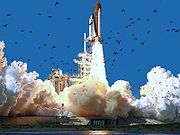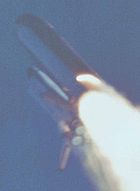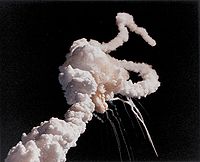
STS-51-L Mission timeline
Encyclopedia

Space Shuttle Orbiter
The Space Shuttle orbiter was the orbital spacecraft of the Space Shuttle program operated by NASA, the space agency of the United States. The orbiter was a reusable winged "space-plane", a mixture of rockets, spacecraft, and aircraft...
.
STS-51-L
STS-51-L
STS-51-L was the twenty-fifth flight of the American Space Shuttle program, which marked the first time an ordinary civilian, schoolteacher Christa McAuliffe, had flown aboard the Space Shuttle. The mission used Space Shuttle Challenger, which lifted off from the Launch Complex 39-B on 28 January...
was the twenty-fifth flight of the American Space Shuttle program
Space Shuttle program
NASA's Space Shuttle program, officially called Space Transportation System , was the United States government's manned launch vehicle program from 1981 to 2011...
, which marked the first time a civilian had flown aboard the Space Shuttle
Space Shuttle
The Space Shuttle was a manned orbital rocket and spacecraft system operated by NASA on 135 missions from 1981 to 2011. The system combined rocket launch, orbital spacecraft, and re-entry spaceplane with modular add-ons...
. The mission used Space Shuttle Challenger
Space Shuttle Challenger
Space Shuttle Challenger was NASA's second Space Shuttle orbiter to be put into service, Columbia having been the first. The shuttle was built by Rockwell International's Space Transportation Systems Division in Downey, California...
, which lifted off from launch pad 39B
Kennedy Space Center Launch Complex 39
Launch Complex 39 is a rocket launch site at the John F. Kennedy Space Center on Merritt Island in Florida, USA. The site and its collection of facilities were originally built for the Apollo program, and later modified to support Space Shuttle operations. NASA began modifying LC-39 in 2007 to...
on January 28, 1986 from Kennedy Space Center
Kennedy Space Center
The John F. Kennedy Space Center is the NASA installation that has been the launch site for every United States human space flight since 1968. Although such flights are currently on hiatus, KSC continues to manage and operate unmanned rocket launch facilities for America's civilian space program...
, Florida
Florida
Florida is a state in the southeastern United States, located on the nation's Atlantic and Gulf coasts. It is bordered to the west by the Gulf of Mexico, to the north by Alabama and Georgia and to the east by the Atlantic Ocean. With a population of 18,801,310 as measured by the 2010 census, it...
. The mission ended in disaster following the destruction
Space Shuttle Challenger disaster
The Space Shuttle Challenger disaster occurred on January 28, 1986, when Space Shuttle Challenger broke apart 73 seconds into its flight, leading to the deaths of its seven crew members. The spacecraft disintegrated over the Atlantic Ocean, off the coast of central Florida at 11:38 am EST...
of Challenger 73 seconds after lift-off because of the failure of an O-ring
O-ring
An O-ring, also known as a packing, or a toric joint, is a mechanical gasket in the shape of a torus; it is a loop of elastomer with a disc-shaped cross-section, designed to be seated in a groove and compressed during assembly between two or more parts, creating a seal at the interface.The O-ring...
seal on Challenger
Solid rocket booster
Solid rocket boosters or Solid Rocket Motors, SRM, are used to provide thrust in spacecraft launches from the launchpad up to burnout of the SRBs. Many launch vehicles include SRBs, including the Ariane 5, Atlas V , and the NASA Space Shuttle...
, which led to the rapid disintegration of the shuttle stack due to overwhelming aerodynamic pressures. The seven-member crew was killed some time after the breakup of the vehicle.
Summary timeline

Solid rocket booster
Solid rocket boosters or Solid Rocket Motors, SRM, are used to provide thrust in spacecraft launches from the launchpad up to burnout of the SRBs. Many launch vehicles include SRBs, including the Ariane 5, Atlas V , and the NASA Space Shuttle...
s were ignited, lifting the shuttle stack off launchpad 39-B at Kennedy Space Center
Kennedy Space Center
The John F. Kennedy Space Center is the NASA installation that has been the launch site for every United States human space flight since 1968. Although such flights are currently on hiatus, KSC continues to manage and operate unmanned rocket launch facilities for America's civilian space program...
. Almost immediately, cameras recording the launch registered the presence of smoke at the field joint next to the attachment strut on the right-hand SRB, indicating the failure of the O-ring
O-ring
An O-ring, also known as a packing, or a toric joint, is a mechanical gasket in the shape of a torus; it is a loop of elastomer with a disc-shaped cross-section, designed to be seated in a groove and compressed during assembly between two or more parts, creating a seal at the interface.The O-ring...
s that were supposed to seal the joint against the 'blow-by' of hot gases from the boosters. However, sometime at around T+2 seconds, a piece of solid fuel from inside the booster moved inside the joint and provided a temporary seal against the blow-by, and, as such, the launch proceeded normally for around forty seconds after launch.
However, at around T+36 seconds and an altitude of just over 10000 feet (3,048 m), Challenger experienced the strongest wind shear ever felt by a Space Shuttle launch. The pitch and yaw commanded by the shuttle's computers in order to counter this wind caused the solid fuel plug to become dislodged from the field joint on the right SRB, and from that moment on the fate of both Challenger and her crew was sealed.

Plume (hydrodynamics)
In hydrodynamics, a plume is a column of one fluid or gas moving through another. Several effects control the motion of the fluid, including momentum, diffusion, and buoyancy...
on the aft attachment strut on the right-hand SRB - ignited gas had begun to force itself through a rapidly growing hole in the field joint. Within a second, the plume became well defined and intense. Internal pressure in the right SRB began to drop because of the rapidly enlarging hole in the failed joint, and at T+60 there was visual evidence of flame coming through the joint and impinging on the external tank. As the mission clock passed up through T+64 seconds, the plume suddenly changed shape, showing that it had burned a hole in the liquid hydrogen
Liquid hydrogen
Liquid hydrogen is the liquid state of the element hydrogen. Hydrogen is found naturally in the molecular H2 form.To exist as a liquid, H2 must be pressurized above and cooled below hydrogen's Critical point. However, for hydrogen to be in a full liquid state without boiling off, it needs to be...
tank in Challengers ET, causing the tank to leak. The pressure in the tank began to drop, whilst meanwhile Challenger
At this stage the situation still seemed normal both to the astronauts and to flight controllers. At T+68, the CAPCOM informed the crew that they were "go at throttle up", and Commander Dick Scobee
Dick Scobee
Francis Richard "Dick" Scobee was an American astronaut. He was killed commanding the Space Shuttle Challenger, which suffered catastrophic booster failure during launch of the STS-51-L mission.-Early life:...
confirmed the call. His response, "Roger, go at throttle up," was the last communication from Challenger on the air-to-ground loop.

At T+73.124, the aft dome of the liquid hydrogen tank failed, producing a propulsive force that pushed the hydrogen tank into the liquid oxygen tank in the forward part of the external tank. At the same time, the right SRB rotated about the forward attach strut, and struck the intertank structure.
The breakup of the vehicle began at T+73.162 seconds and at an altitude of 48,000 feet (14.6 kilometres (9.1 mi)). With the external tank disintegrating, Challenger veered from its correct attitude with respect to the local air flow and was immediately torn apart by abnormal aerodynamic forces resulting in a load factor
Load factor
Load factor may refer to:* Load factor , the ratio of the lift of an aircraft to its weight* Load factor , the ratio of the number of records to the number of addresses within a data structure...
of up to 20g
G-force
The g-force associated with an object is its acceleration relative to free-fall. This acceleration experienced by an object is due to the vector sum of non-gravitational forces acting on an object free to move. The accelerations that are not produced by gravity are termed proper accelerations, and...
– well over its design limit. The two SRBs, which can withstand greater aerodynamic loads, separated from the ET and continued in uncontrolled powered flight for another 37 seconds. The SRB casings were made of 12.7 millimetre (0.5 in) thick steel and were much stronger than the orbiter and ET; thus, both SRBs survived the breakup of the space shuttle stack, even though the right SRB was still suffering the effects of the joint burn-through that had set the destruction of Challenger in motion. The boosters were destroyed by the range safety system at around 110 seconds after launch.

Detailed timeline and transcript
The following timeline provides a detailed list of the major events of the launch of STS-51-LSTS-51-L
STS-51-L was the twenty-fifth flight of the American Space Shuttle program, which marked the first time an ordinary civilian, schoolteacher Christa McAuliffe, had flown aboard the Space Shuttle. The mission used Space Shuttle Challenger, which lifted off from the Launch Complex 39-B on 28 January...
, culminating in the destruction of Challenger. The list also contains a transcript from the shuttle's Cockpit Voice Recorder (CVR), from ignition of the main engines to T+73 seconds. Acronyms used in the timeline are as follows:
- CVR - Cockpit Voice Recorder
- APU - Auxilixary Power Unit
- ET - External Tank
- GPC - General Purpose Computer
- GLS - Ground Launch Sequencer
- HPFT - High Pressure Fuel Turbopump
- LH2 - Liquid Hydrogen
- LO2 - Liquid Oxygen (same as LOX)
- MEC - Main Engine Controller
- PIC - Pyrotechnics Initiator Controller
- psf - Pounds per square foot
- psi - Pounds per square inch
- RCS - Reaction Control SystemReaction control systemA reaction control system is a subsystem of a spacecraft whose purpose is attitude control and steering by the use of thrusters. An RCS system is capable of providing small amounts of thrust in any desired direction or combination of directions. An RCS is also capable of providing torque to allow...
- CDR - Commander
- PLT - Pilot
- MS1/MS2 - Mission specialist
- PAO - Public Affairs Officer
- MCC - Mission Control Center
Time (UTC) (hr:min:sec) Mission Elapsed Time (MET) (sec) Event Source 16:37:53.444 -6.566 SSME-3 ignition command. GPC 16:37:53.564 -6.446 SSME-2 ignition command. GPC 16:37:53.684 -6.326 SSME-1 ignition command. GPC 16:37:54 -6 CDR: "There they go guys!"
MS2: "All right!"
CDR: "Three at a hundred."CVR 16:38:00.010 0.000 SRB ignition command. GPC 16:38:00.018 0.008 Holddown Post 2 PIC firing. E8 Camera 16:38:00 0 MS2: "Aall riight!" CVR 16:38:00.260 0.250 First continuous vertical motion. E9 Camera The O-rings in the right-hand SRB field joint fail. 16:38:00.688 0.678 First confirmed puff of smoke appears above SRB/ET attachment ring field joint on right-hand SRB. E60 Camera 16:38:00.846 0.836 Eight puffs of smoke appear above field joint, lasting from T+0.836 to T+2.5 seconds MET. E63 Camera 16:38:00.900 0.890 Ground launch sequence computers begin post-liftoff "safing" of launch pad structures and equipment. GLS 16:38:01 1 PLT: "Here we go." CVR 16:38:02.743 2.733 Last evidence of smoke from field joint. CZR-1 Camera 16:38:03 3 PAO: "Liftoff of the 25th space shuttle mission, and it has cleared the tower." NASA TV A solid-fuel 'plug' seals the gap formed by the O-ring 'blow-by'. 16:38:03.385 3.375 Last evidence of smoke. E60 camera 16:38:04.349 4.339 SSMEs throttled up to 104% E41M2076D 16:38:05 5 DPS: "Liftoff confirmed."
Flight Director: "Liftoff..."MCC 16:38:05.684 5.674 Right-hand SRB pressure 11.8 psi Pounds per square inchThe pound per square inch or, more accurately, pound-force per square inch is a unit of pressure or of stress based on avoirdupois units...
above normal.B47P2302C 16:38:07 7 CDR: "Houston, Challenger - Roll program." CVR 16:38:07.734 7.724 Roll program initiated. V90R5301C 16:38:10 10 CAPCOM: "Roger roll, Challenger."
FIDO: "Good roll, flight."
Flight Director: "Rog, good roll."MCC 16:38:11 11 PLT: "Go you Mother!" CVR 16:38:14 14 MS1: "LVLH" CVR 16:38:15 15 MS2: "(Expletive) hot!"
CDR: "OK."CVR 16:38:16 16 PAO: "Good roll program confirmed. Challenger now heading downrange." NASA TV 16:38:19 19 PLT: "Looks like we've got a lotta wind here today." CVR 16:38:19.869 19.859 SSMEs throttled back to 94% E41M2076D 16:38:20 20 CDR: "Yeah." CVR 16:38:21.134 21.124 Roll program completed. VP0R5301C 16:38:22 22 CDR: "It's a little hard to see out my window here." CVR 16:38:27 27 BOOSTER: "Throttle down to 94."
Flight Director: "Ninety four..."MCC 16:38:28 28 PLT: "There's ten thousand feet and Mach point five." CVR 16:38:28 28 PAO: "Engines beginning throttling down, now at 94 percent. Normal throttle for most of the flight is 104 percent. We'll throttle down to 65 percent shortly." NASA TV 16:38:30 30 [Garble] CVR 16:38:35 35 CDR: "Point nine." CVR 16:38:35.389 35.379 SSMEs throttled back to 65% E41M2076D 16:38:37.000 36.990 Roll and Yaw Attitude Response to wind shear (36.990 to 62.990 sec). V95H352nC The solid fuel 'plug' is dislodged. 16:38:40 40 PLT: "There's Mach one." CVR 16:38:41 41 CDR: "Going through nineteen thousand." CVR 16:38:43 43 CDR: "OK, we're throttling down." CVR 16:38:45.227 45.217 A flash is observed downstream of the shuttle's right wing. 16:38:48.128 48.118 A second flash is seen trailing the right wing. 16:38:48.428 48.418 A third unexplained flash is seen downstream of the shuttle's right-hand wing - a brilliant orange ball of flame appears to emerge from under the right wing and quickly merges with the plume of the solid rocket boosters, a phenomenon noted on previous flights. 70mm Camera 16:38:49 49 BOOSTER: "Three at 65."
PAO: "...Three good fuel cells. Three good APUs..."
Flight Director: "Sixty-five, FIDO..."
FIDO: "T-del confirms throttles."
Flight Director: "...Thank you."MCC & NASA TV 16:38:51.870 51.860 SSMEs throttled up to 104% E41M2076D 16:38:52 52 PAO: "Velocity 2,257 feet per second (1,539 mph), altitude 4.3 nautical miles, downrange distance 3 nautical miles..." NASA TV 16:38:57 57 CDR: "Throttling up." CVR 16:38:58 58 PLT: "Throttle up." CVR 16:38:58.798 58.788 First evidence of flame on right-hand SRB. E207 Camera 16:38:59 59 CDR: "Roger." CVR 16:38:59.010 59.000 Reconstructed Max Q (720 psf) Best estimated trajectory 16:38:59.272 59.262 Continuous well-defined plume of flame on right-hand SRB. E207 Camera 16:38:59.763 59.753 Flame from right-hand SRB in downwards direction (seen from south side of vehicle). E204 Camera 16:38:60 60 PLT: "Feel that mother go!"
"Woooohoooo!"CVR 16:39:00.014 60.238 Pressures in right- and left-hand SRBs begin to diverge. B47P2302 16:39:00.248 60.238 First evidence of intermittent plume deflection. E207 Camera 16:39:00.258 60.248 First evidence of SRB plume attaching to ET ring frame. E203 Camera 16:39:00.998 60.988 First evidence of continuous plume deflection. E207 Camera 16:39:01.734 61.724 Peak roll rate in response to wind shear. V90R5301C 16:39:02 62 PLT: "Thirty-five thousand going through one point five." CVR 16:39:02.094 62.084 Peak TVC response to wind shear. B58H1150C 16:39:02.414 62.404 Peak yaw response to wind shear. V90R5341C 16:39:02.494 62.484 Right-hand outboard elevon actuator hinge moment spike. V58P0966C 16:39:03.934 63.924 RH outboard elevon actuator delta pressure change. V58P0966C 16:39:03.974 63.964 Start of planned pitch rate manoeuvre. V90R5321C The plume of flame burns through the LH2 tank in the ET. 16:39:04.670 64.660 Change in anomalous plume shape (LH2 tank leak near 2058 ring frame). E204 Camera 16:39:04.715 64.705 Bright sustained glow on sides of ET E204 Camera 16:39:04.947 64.937 Start SSME gimbal angle large pitch variations V58H1100A 16:39:05 65 CDR: "Reading four eighty six on mine." CVR 16:39:05.174 65.164 Beginning of transient motion due to changes in aero forces due to plume. V90R5321C 16:39:06 66 BOOSTER: "Throttle up, three at 104."
Flight Director: "CAPCOM, go at throttle up."MCC 16:39:06.774 66.764 Start ET LH2 ullage pressure deviations. T41P1700C 16:39:07 67 PLT: "Yep, that's what I've got, too." CVR 16:39:08 68 PAO: "Engines are throttling up. Three engines now at 104 percent."
CAPCOM: "Challenger, go at throttle up."NASA TV & MCC 16:39:10 70 CDR: "Roger, go at throttle up." (Last transmission on air-to-ground voice loop). CVR The flame burns through the lower attachment strut on the right-hand SRB, causing the SRB to move away from the ET. 16:39:12.214 72.204 Left- and right-hand SRB yaw rates begin to diverge. V90R2528C 16:39:12.294 72.284 Left- and right-hand SRB pitch rates begin to diverge. V90R2525C 16:39:12.488 72.478 SRB major high-rate actuator command. V79H2111A 16:39:12.507 72.497 SSME roll gimball rates 5 deg/sec. V58H1100A 16:39:12.535 72.525 Vehicle max +Y lateral acceleration (+.227 g). V98A1581C 16:39:12.574 72.564 SRB major high-rate actuator motion. B58H1151C 16:39:12.574 72.564 Start of H2 tank pressure decrease with 2 flow control valves open. T41P1700C 16:39:12.634 72.624 Last state vector downlinked. Data reduction 16:39:12.974 72.964 Start of sharp MPS LOX inlet pressure drop. V41P1330C 16:39:13 73 PLT: "Uh-oh..." CVR 16:39:13.020 73.010 Last full computer frame of TDRS data. Data reduction 16:39:13.054 73.044 Start of sharp MPS LH2 inlet pressure drop. V41P1100C 16:39:13.055 73.045 Vehicle max -Y lateral acceleration (-.254 g). V98A1581C Challenger begins to disintegrate. 16:39:13.134 73.124 Circumferential white pattern on ET aft dome (LH2 tank failure). The bottom of the ET is open and liquid hydrogen spills. E204 Camera 16:39:13.134 73.124 Right-hand SRB pressure 19 psi lower than left-hand SRB B47P2302C 16:39:13.147 73.137 First hint of vapour at intertank. E207 Camera 16:39:13.153 73.143 All engine systems start responding to loss of fuel and LOX inlet pressure. SSME team 16:39:13.172 73.162 Sudden cloud along ET between intertank and aft dome. The right booster slams into the ET just as the LH2 tank is thrust into the oxygen tank. E207 Camera 16:39:13.201 73.191 Flash between Orbiter & LH2 tank. E204 Camera 16:39:13.221 73.211 SSME telemetry data interference from 73.211 to 73.303. Data reduction 16:39:13.223 73.213 Flash near SRB forward attachment strut and brightening of flash between Orbiter and ET E204 Camera 16:39:13.292 73.282 First indication intense white flash at SRB fwd attach point. E204 Camera 16:39:13.337 73.327 Greatly increased intensity of white flash. E204 Camera 16:39:13.387 73.377 Start of RCS jet chamber pressure fluctuations. V42P1552A 16:39:13.393 73.383 All engines approaching HPFT discharge temp redline limits. E41Tn010D 16:39:13.492 73.482 ME-2 HPFT discharge temperature. Channel A votes for shutdown; 2 strikes on Channel B. MEC data 16:39:13.492 73.482 SSME-2 controller last time word update. MEC data 16:39:13.513 73.503 SSME-3 in shutdown due to HPFT discharge temperature redline exceedance. MEC data 16:39:13.513 73.503 SSME-3 controller last time word update. MEC data 16:39:13.533 73.523 SSME-1 in shutdown due to HPFT discharge temperature redline exceedance. Calculation 16:39:13.553 73.543 SSME-1 last telemetered data point. Calculation 16:39:13.628 73.618 Last validated Orbiter telemetry measurement. V46P0120A 16:39:13.641 73.631 End of last reconstructured data frame with valid synchronization and frame count. Data reduction 16:39:14.140 74.130 Last radio frequency signal from Orbiter Data reduction Loss of downlink - Challenger is lost. 16:39:14.597 74.587 Bright flash in vicinity of Orbiter nose. E204 Camera 16:39:16.447 76.437 Right-hand SRB nose cap separation & parachute deployment. E207 Camera 16:39:29 89 Flight Director: "FIDO, trajectories..."
FIDO: "Go ahead."
Flight Director: "Trajectory, FIDO."
FIDO: "Flight, FIDO, filters got discreting sources. We're go."
GC: "Flight, GC, we've had negative contact, loss of downlink."
Flight Director: "OK, all operators, watch your data carefully."
FIDO: "Flight, FIDO, till we get stuff back he's on his cue card for abort modes."
Flight Director: "Procedures, any help?"
Unknown: "Negative, flight, no data."MCC 16:39:50.260 110.250 Destruction of right-hand SRB via Range Safety System. E202 Camera. 16:39:50.262 110.252 Destruction of left-hand SRB via Range Safety System. E230 Camera
External links
- NASA Transcript
- Spaceflight Now. The Challenger Accident Timeline

